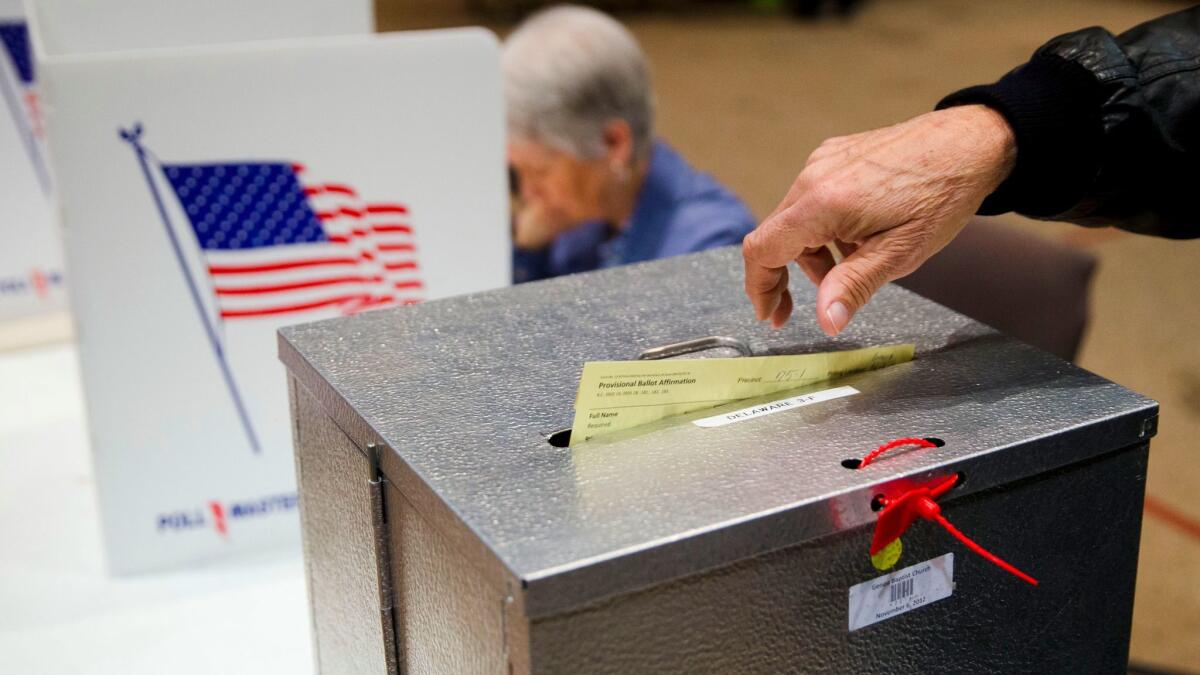Editorial: Don’t suppress the vote, but keep track of voters

- Share via
Reversing the position it took during the Obama administration, the U.S. Department of Justice under President Trump last week asked the Supreme Court to uphold a procedure the state of Ohio wants to use to purge some voters from its election rolls — a practice that disproportionately disenfranchises poor and minority voters.
The court should decline the invitation and rule that Ohio is violating the 1993 National Voter Registration Act. That landmark law prohibits states from purging registered voters from the rolls just because they failed to vote.
It’s common for states (including California) to remove from the rolls voters who have moved from the area or died. But Ohio also targets for removal voters who don’t engage in “voter activity” for two years — a single election cycle. Unless they respond to a letter from election officials to confirm that they haven’t moved, they’ll be dropped from the rolls if they fail to vote or re-register over the next four years.
The challenge is to modernize election record-keeping without engaging in policies — such as the one used by Ohio — that penalize eligible voters
Ohio argues that its procedure is justified by language added to federal law in 2002. But the U.S. 6th Circuit Court of Appeals rejected the state’s interpretation last year. The appeals court said that using a lack of voter activity as a “trigger” for beginning the purge process made a “paper tiger” of the law’s ban on purges for not voting.
There is evidence that Ohio’s policy would have harmed a significant number of perfectly eligible voters. After the appeals court decision, a federal district court issued an injunction that allowed 7,500 Ohio voters who otherwise would have been purged under the state’s rule to cast votes in the 2016 presidential election. These were voters who apparently hadn’t responded to (or perhaps simply hadn’t received) a notice from election officials seeking to confirm that their address hadn’t changed.
Ideally, those voters and others would participate in every election, but choosing to skip one or more elections shouldn’t be grounds for disqualification from voting in the future. That was the judgment Congress made when it enacted the National Voter Registration Act, whose stated objectives included getting more eligible voters to register.
It’s true that increasing voting wasn’t the law’s only goal. It also aimed to “ensure that accurate and current voter registration rolls are maintained.” In its ruling striking down Ohio’s purge policy, the 6th Circuit said that increasing turnout and maintaining accurate voter rolls were “sometimes conflicting mandates.”
But even if you think that ease of voting is the more important value, it’s important that elections are administered in a way that inspires public confidence.
In 2012, a study by the Pew Center on the States found that 24 million voter registrations were “no longer valid” or “significantly inaccurate,” and that more than 1.8 million dead individuals were listed as as eligible to vote.. It further found that about 2.75 million people were registered to vote in more than one state.
Donald Trump cited this study during last year’s campaign when he was warning that the election might be “rigged” against him. Characteristically, Trump was jumping to a conclusion: The fact that registration records are outdated or inaccurate doesn’t mean that actual votes are being cast fraudulently. Even so, as the authors of the Pew report said, such inaccuracies “waste taxpayer dollars, undermine voter confidence and fuel partisan disputes over the integrity of our elections.”
The challenge is to modernize election record-keeping without engaging in policies — such as the one used by Ohio — that penalize eligible voters.
In a previous study, Pew suggested that registration records could be made more accurate if election officials compared registration lists with a broader array of data sources and established new ways for voters to submit updated information online.
That’s where the emphasis should be placed — on affirmative ways to keep records up to date that don’t inadvertently disenfranchise eligible voters.
Follow the Opinion section on Twitter @latimesopinion and Facebook
More to Read
A cure for the common opinion
Get thought-provoking perspectives with our weekly newsletter.
You may occasionally receive promotional content from the Los Angeles Times.






